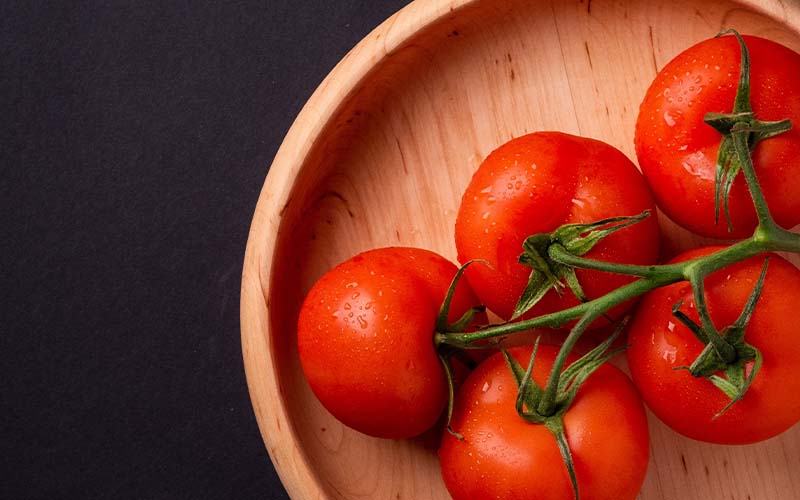Tomato (Solanum Lycopersicum), is a flowering plant of the nightshade family cultivated for its edible fruits. Regarded as a vegetable by nutritionists, tomatoes are a good source of
phytochemical lycopene and vitamin C. They are commonly eaten raw in salads, served as a cooked vegetable, or as a garnishing ingredient of various prepared dishes. Many of the world’s tomatoes are also used for processed products such as canned tomatoes, tomato juice, ketchup, purée, and paste.
There are over 7500 tomato variants of harvested tomatoes around the world. Some variants include globe tomatoes (for processing and raw consumption); beefsteak tomatoes (suitable for sandwiches); oxheart tomatoes (strawberry-shaped); plum tomatoes (suitable for sauce and paste) and cherry tomatoes (sweet and usually eaten whole in salads).
Physical descrition and cultivation
Tomato plants are branched, usually spreading between 60-180 cm (24-72 inches). Their hairy-like leaves possess a strong scent and can grow up to 45 cm (18 inches) long. The tomato fruit grows as berries with varying diameters ranging from 1.5 to 7.5 cm (0.6 to 3 inches). They are typically red or yellow, although varieties of green and purple exist, with differing shapes from almost spherical to oval and pear-shaped. Each fruit contains a minimum of two cells with small seeds surrounded by jellylike pulp.
The plant requires relatively warmth and sunlight, as a result it is largely nursed in hothouses when planted in cooler climates. Tomatoes are either staked, tied, or caged to keep their stems and fruits off the ground, and consistently watered to avoid blossom-end rot and cracking of the fruits. The plants are prone to many pests and diseases such as bacterial wilt, early blight, mosaic virus, and tomato horn worms. The use of fungicides and pesticides and the planting of resistant varieties can however help control these threats. The tiny currant tomato is a related species which have been used by breeders to hybridize several pests and disease-resistant tomato varieties.
History
Tomatoes originated in the Andes Mountains of South America, possibly in Peru and Ecuador, and are believed to have been domesticated in pre-Columbian Mexico. Its name is derived from the Nahuatl (Aztec) word tomato. The tomato plant was introduced to Europe by the Spanish in the early 16th century, making them the first Europeans to adopt it as food. In France and Northern Europe, tomatoes were initially grown merely as an ornamental plant and hesitantly considered as a food due to their relation to the poisonous belladonna and deadly nightshade. Indeed, the roots and leaves of the tomato plant are poisonous as they contain neurotoxin solanine.
Processing
The demand for tomato processing usually arises from a need to preserve the product for home use (stews, soups, salads etc.), off-season or to add value for more income. Traditionally, the concentration (to a paste or puree) and drying either fruit pieces or to a powder are the most common methods used and continue to be the most suitable processes for many people.
Drying
Traditional methods in hot, dry regions include sun drying. Tomatoes are split and either placed on a clean flat surface (e.g., a roof) displaying the cut side or held together with strings and hanged in the sun with a branch or beam. The pace of drying is usually determined by the temperature and humidity of the air and the open nature of it exposes the fruit to insects, dirt, and dust. This can be reduced by covering the tomatoes with a muslin cloth or mosquito net. The end-product is dark-red, fibrous pieces with a strong tomato flavour.
Provided that the humidity is low, the dried product can be kept without special packaging for several months. If the humidity rises, the product will go mouldy and hence needs to be protected. They can either be put in clean containers and jars or be dried slowly over a fire to allow moisture content. The tomatoes mustn’t have direct contact with fire to prevent it from cooking.
Tomato pulp
Tomato pulp can be prepared using a pestle and mortar, a mill, a small pulping machine. It is advisable to remove the seeds and skins which can be done by sieving through a medium mesh or, in the case of some pulpers, these parts are separated by the machine. The pulp can be used for several products such as concentrated purée or paste, jam, juice, or fruit leather.
Tomato purée or paste
Tomato purée and paste are formed by concentrating tomato pulp by removing the water. The moisture can be removed by careful heating or by pressing the pulp through a filter or drip bag.
Tomato juice and squash
Tomato juice can be separated from the pulp by filtering, but more commonly the entire pulp is used as juice. The juice is bottled and pasteurized to extend its shelf life.
Tomato Leather
Tomato pulp can be mixed with spices according to one’s taste and availability and used to make fruit leather. The pulp is heated and spread in a thin layer that is dried. After drying, the leather is cut and rolled into balls or cubes which can be rehydrated and used in a range of soups, stews, and sauces.


Comments are closed.